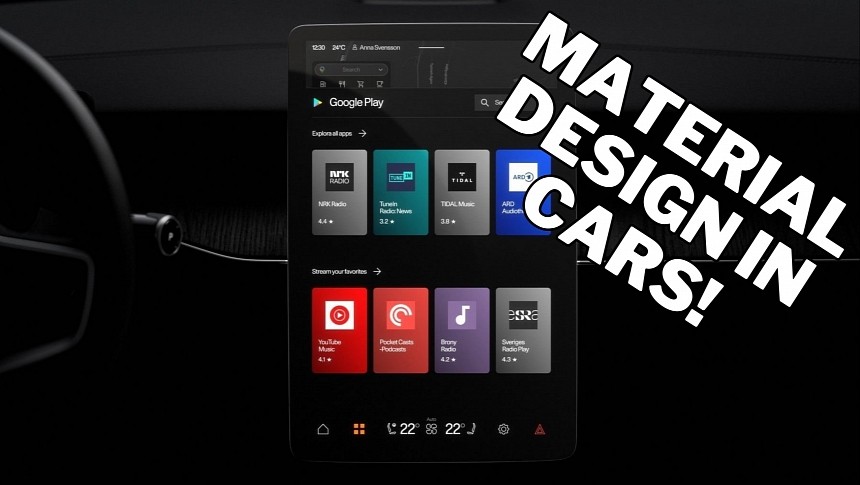I don't know about you, but as a geek, I'm a huge fan of the latest design languages used by companies like Microsoft and Google. Fluent Design, Mica effects, and Material Design are all signs that software design is evolving substantially, staying in line with the latest feature innovations.
On Windows 11, for example, the new design language makes everything on the desktop feel more dynamic and fluid. The same thing happens on Android, where Material Design is rapidly expanding.
Google is now working on bringing Material Design to Android Automotive as well, but as compared to the mobile implementation, the company wants to leave carmakers in charge of the looks. This approach obviously makes sense, as auto manufacturers must be able to decide the looks of the operating system, but on the other hand, it could lead to Android Automotive becoming quite dull in some cars.
With Material Design, Google provides Android users with a more dynamic experience by allowing the colors and the visual effects to adapt to whatever runs on the screen. As such, the design decisions are made by an algorithm, providing users with a consistent design that carmakers would definitely have a hard time putting together.
Now that Material Design is expanding to Android Automotive, drivers would essentially get access to the same recipe as on mobile devices. Google, however, has pledged to keep carmakers in full control of the infotainment unit, so they will also be the ones to choose the theme and colors available on Android Automotive.
One of the main benefits of using Android Automotive is the rich set of tools that allows carmakers to retain their brand identity. As such, when adopting Android Automotive, the operating system can be customized with a look and feel that would be completely different from what a competitor uses in their own models. At the end of the day, this means that Android Automotive would look completely different in GM and Honda cars, despite the same operating system serving as the foundation of the infotainment unit.
The new Material Design policy is part of this set of rules that gives carmakers full control over the operating system's look. Sure enough, this could also mean that car manufacturers, who aren't exactly known for excelling in terms of software design, might eventually make Android Automotive less exciting than it could be.
In the meantime, Android Automotive is at the core of a major controversy, as General Motors wants to adopt the operating system and block Android Auto and CarPlay in its cars. The company is accused of trying to enforce a subscription model on customers, especially as, in theory, Android Automotive would support running both Android Auto and CarPlay with the right toolset.
Google is now working on bringing Material Design to Android Automotive as well, but as compared to the mobile implementation, the company wants to leave carmakers in charge of the looks. This approach obviously makes sense, as auto manufacturers must be able to decide the looks of the operating system, but on the other hand, it could lead to Android Automotive becoming quite dull in some cars.
With Material Design, Google provides Android users with a more dynamic experience by allowing the colors and the visual effects to adapt to whatever runs on the screen. As such, the design decisions are made by an algorithm, providing users with a consistent design that carmakers would definitely have a hard time putting together.
Now that Material Design is expanding to Android Automotive, drivers would essentially get access to the same recipe as on mobile devices. Google, however, has pledged to keep carmakers in full control of the infotainment unit, so they will also be the ones to choose the theme and colors available on Android Automotive.
One of the main benefits of using Android Automotive is the rich set of tools that allows carmakers to retain their brand identity. As such, when adopting Android Automotive, the operating system can be customized with a look and feel that would be completely different from what a competitor uses in their own models. At the end of the day, this means that Android Automotive would look completely different in GM and Honda cars, despite the same operating system serving as the foundation of the infotainment unit.
The new Material Design policy is part of this set of rules that gives carmakers full control over the operating system's look. Sure enough, this could also mean that car manufacturers, who aren't exactly known for excelling in terms of software design, might eventually make Android Automotive less exciting than it could be.
In the meantime, Android Automotive is at the core of a major controversy, as General Motors wants to adopt the operating system and block Android Auto and CarPlay in its cars. The company is accused of trying to enforce a subscription model on customers, especially as, in theory, Android Automotive would support running both Android Auto and CarPlay with the right toolset.
Google's working to bring Material Design to Android Automotive OS, but unlike on phones, colors will be chosen by the OEM instead of derived by an algorithm ???? pic.twitter.com/OvzSZNIA0e
— Mishaal Rahman (@MishaalRahman) May 4, 2023










